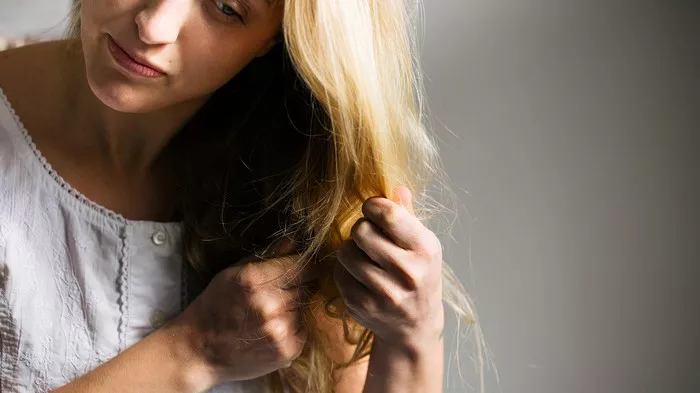Hair is often referred to as one’s crowning glory, symbolizing vitality and beauty. However, factors such as excessive heat styling, chemical treatments, environmental aggressors, and poor hair care routines can lead to various forms of damage, leaving hair looking dull, brittle, and lifeless. Understanding the causes and types of hair damage is crucial in implementing effective repair solutions and preventing further harm. In this article, we delve into the realm of damaged hair, exploring its intricacies and offering practical advice on how to restore and maintain healthy locks.
Understanding Hair Damage
Hair damage can manifest in numerous ways, stemming from a variety of causes. Common culprits include:
1. Heat Styling: Excessive use of hairdryers, straighteners, and curling irons can strip the hair of its natural moisture, leading to dryness, breakage, and dullness.
2. Chemical Treatments: Perms, relaxers, bleaching, and dyeing can weaken the hair’s structure, causing it to become brittle, prone to breakage, and susceptible to color damage.
3. Environmental Factors: Exposure to UV rays, pollution, humidity, and harsh weather conditions can parch the hair, leaving it dry, frizzy, and prone to damage.
4. Poor Hair Care Routines: Over-washing, using harsh shampoos, neglecting regular conditioning, and vigorous towel-drying can exacerbate hair damage, stripping away essential oils and weakening the hair shaft.
Types of Hair Damage
Hair damage manifests in various forms, each requiring specific care and attention:
1. Split Ends: Occur when the hair shaft splits into two or more fragments, usually caused by dryness and mechanical stress.
2. Breakage: Refers to the snapping of hair strands, often resulting from excessive manipulation, chemical treatments, or lack of moisture.
3. Dryness: Characterized by a lack of moisture in the hair shaft, leading to rough texture, frizz, and brittleness.
4. Color Damage: Occurs when the hair’s cuticle layer is compromised due to chemical treatments, resulting in fading, discoloration, and loss of shine.
Hair Repair Solutions
Repairing damaged hair requires a multi-faceted approach, incorporating both professional treatments and at-home remedies:
1. Deep Conditioning Masks: Infused with nourishing ingredients such as argan oil, shea butter, and keratin, deep conditioning masks penetrate the hair shaft, replenishing moisture and restoring elasticity.
2. Protein Treatments: Formulated with hydrolyzed proteins, these treatments strengthen the hair from within, repairing damage and preventing breakage.
3. Natural Remedies: Ingredients like coconut oil, avocado, honey, and egg yolk possess moisturizing and strengthening properties, making them ideal for DIY hair masks.
Product Recommendations
When selecting products for damaged hair, look for formulations enriched with the following ingredients:
1. Hydrating Oils: Argan oil, coconut oil, and jojoba oil replenish moisture and improve hair texture.
2. Protein Complexes: Keratin, silk amino acids, and wheat protein strengthen the hair shaft and reduce breakage.
3. Vitamins and Antioxidants: Vitamin E, Biotin, and antioxidants protect the hair from environmental damage and promote overall health.
Recommended products include:
1. Moroccan Oil Intense Hydrating Mask
2. Olaplex Hair Perfector No. 3
3. SheaMoisture Manuka Honey & Yogurt Hydrate + Repair Protein Power Treatment
Preventative Measures
To prevent future hair damage, consider the following tips:
1. Use Heat Protectant Sprays: Apply a heat protectant spray before using heat styling tools to minimize damage.
2. Limit Heat Styling: Reduce the frequency of heat styling and opt for heat-free styling methods whenever possible.
3. Avoid Harsh Chemicals: Opt for gentle, sulfate-free shampoos and minimize the use of chemical treatments.
4. Protective Styling: Wear hairstyles that minimize manipulation and friction, such as braids, buns, or protective wraps.
5. Regular Trims: Schedule regular trims every 6-8 weeks to remove split ends and prevent further damage.
Professional Advice
For personalized advice and treatment options, consult with a professional hairstylist or trichologist. They can assess the extent of damage and recommend tailored solutions to restore and maintain hair health.
DIY Hair Masks
Try these DIY hair mask recipes using natural ingredients:
1. Coconut Avocado Mask:
- Ingredients: 1 ripe avocado, 2 tablespoons coconut oil
- Instructions: Mash the avocado and mix with melted coconut oil. Apply to damp hair, leave on for 30 minutes, then rinse thoroughly.
2. Honey Yogurt Mask:
- Ingredients: 1/2 cup plain yogurt, 2 tablespoons honey
- Instructions: Mix yogurt and honey until smooth. Apply to clean, damp hair, leave on for 20-30 minutes, then rinse with lukewarm water.
Step-by-Step Guides
For optimal results, follow these steps when applying hair treatments:
1. Cleanse: Start with a clarifying shampoo to remove buildup and impurities from the hair and scalp.
2. Apply Treatment: Generously apply the chosen treatment, focusing on the mid-lengths and ends of the hair.
3. Massage: Gently massage the treatment into the hair and scalp to ensure even distribution.
4. Cover: For deeper penetration, cover the hair with a shower cap or warm towel.
5. Wait: Allow the treatment to sit for the recommended time, usually 20-30 minutes.
6. Rinse: Thoroughly rinse the treatment out of the hair with lukewarm water.
7. Condition: Follow up with a moisturizing conditioner to seal the hair cuticle and lock in nutrients.
By understanding the causes of hair damage, implementing effective repair solutions, and adopting preventative measures, you can restore your hair’s health and vitality. Whether utilizing professional treatments or DIY remedies, nurturing your hair with care and attention will ensure that it remains your crowning glory for years to come.


